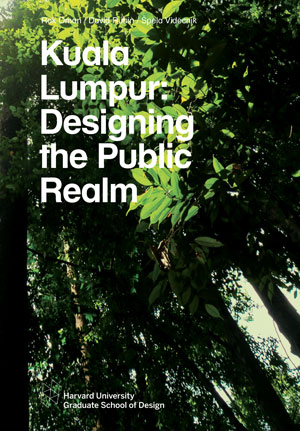Kuala Lumpur / Discovering Traces
The city is a landscape. The connective tissue that binds us all together is the space between buildings, and sometimes on top of them. It represents a greater percentage of the fabric that defines a city, when one considers all of the opportunities outside of the building envelope. It is the most equitable form of engagement, where the extent of constituency has the opportunity to engage with each other, whether economically challenged or privileged. It is the low-hanging fruit – the least expensive means to positively inform the greatest number of people. Humanity exists on this common ground – landscape – and when you believe in this holistically, you concentrate your efforts on making connections between people happen.
Kuala Lumpur is an extraordinary capital, informed by multiple cultures and a large population – a population density of 6,696 inhabitants per square km that is expected to triple by 2050. The diverse constituency is largely comprised of Bumiputuri and Chinese, as well as Indians and subpopulations of Eastern Malaysia. Religious affiliations include Islamists, Buddhists, Hindus, Christians and Taoists in descending order of population. The landscape of the city is informed by all of these people and more. It is within the urban landscape where we will strive to bring them into a common and progressive dialogue. In an era of nationalism and xenophobia here in the United States, it is important to recognize that the design of human habitation necessitates a global approach – one that will positively inform an understanding between diverse populations.
This option studio will focus on a complex area inside the city center that embraces the business district of Kuala Lumpur City Centre (KLCC), part of the channelized Klang River trapped between a highway and a historic Muslim cemetery, and the traditional Malay enclave of Kampung Baru – a culturally valued low-income village trapped in time (and the threat of development). The 1.5 km diameter study area serves as an illustration of the city’s complex ethnic and social fabric, and the pressures of rapid global development.
The studio will focus on alternative methods of planning to create an urban tissue that, rather than segregate private and public space, explores the potential of a hybrid condition. Students will investigate the prospect for densification, increased diverse programmatic use, and sustainability – economic, environmental, and social – while preserving cultural identity. The solutions will look to improve the quality of public life and establish alternative means to incorporate an urban plan, architectural form, connections and programming. By negotiating between the large urban scale and small architectural interventions (both building and landscape), contemporary and vernacular design, new strategies for creating collective space will be explored within the built environment. It is here, in the context of this connective tissue that we will explore the nature of place, and with aspiration, bring people together in a positive dialogue.
This studio meets on an irregular schedule. Studio meetings will take place on the following Tuesdays and Thursdays: January 24 (SV, RO), 31 (DR), February 9 (SV, RO, DR), 16 (DR), 18-26 (site visit to Kuala Lumpur), March 9 (SV, RO, DR), 21 (SV, RO, DR), 23 (DR), 28 (DR), April 4 (SV, DR), 6 (SV), 11 (SV), 13 (SV, DR), 18 (SV), 20 (SV, DR), 25 (SV, RO, DR), 27 (SV, RO – optional)
Publications
-

Kuala Lumpur: Designing the Public Realm
Rok Oman, David Rubin and Spela Videcnik
October 2017